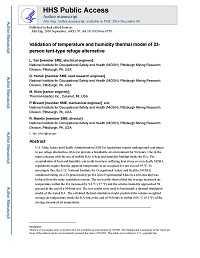Mining Publication: Validation of Temperature and Humidity Thermal Model of 23-person Tent-type Refuge Alternative
Original creation date: September 2016
U.S. Mine Safety and Health Administration (MSHA) regulations require underground coal mines to use refuge alternatives (RAs) to provide a breathable air environment for 96 hours. One of the main concerns with the use of mobile RAs is heat and humidity buildup inside the RA. The accumulation of heat and humidity can result in miners suffering heat stress or even death. MSHA regulations require that the apparent temperature in an occupied RA not exceed 95°F. To investigate this, the U.S. National Institute for Occupational Safety and Health (NIOSH) conducted testing on a 23-person tent-type RA in its Experimental Mine in a test area that was isolated from the mine ventilation system. The test results showed that the average measured air temperature within the RA increased by 9.4°C (17°F) and the relative humidity approached 94 percent at the end of a 96-hour test. The test results were used to benchmark a thermal simulation model of the tested RA. The validated thermal simulation model predicted the volume-weighted average air temperature inside the RA tent at the end of 96 hours to within 0.06°C (0.1°F) of the average measured air temperature.
Authors: L Yan, DS Yantek, M Klein, P Bissert, RJ Matetic
Peer Reviewed Journal Article - September 2016
NIOSHTIC2 Number: 20048832
Min Eng 2016 Sep; 68(9):97-103
See Also
- Advancement of Refuge Alternatives for Underground Coal Mines
- Announcing Two New Sister Publications on Refuge Alternatives
- Emergency Escape and Refuge Alternatives
- How to Operate a Refuge Chamber: A Quick Start Guide
- Investigation of Temperature Rise in Mobile Refuge Alternatives
- NIOSH Refuge Alternative Webinar
- Refuge Alternatives in Underground Coal Mines
- Refuge Chamber Expectations Training - 1.0
- Technology News 537 - NIOSH Develops New Mine Refuge Chamber Training
- When Do You Take Refuge? Decisionmaking During Mine Emergency Escape
- Content source: National Institute for Occupational Safety and Health, Mining Program


 ShareCompartir
ShareCompartir
